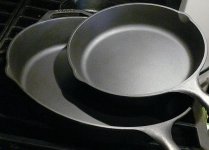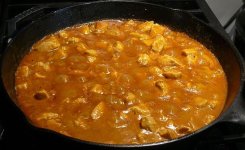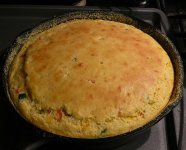I have not done just one pan Doug, I have a whole stack of them. And I've had many failures and had to strip and redo with better methods. Flaking, too fragile (the scraping hard with stainless spoon test), poor non-stick qualities, weak color, and so on. I'm in a hurry (the stainless was coming out of the lye to be given away as the iron was going in) so I have to accelerate the learning curve, apply everything I know, learn a bunch of new stuff, do a lot of experimenting.
I do not apply oil at 350, more like 200 if that using an IR thermometer. I do not heat raw iron in the oven. I have gas and get flash rust. I heat on the stove top. I only want enough heat to drop the viscosity of the oil so I can buff it out. I do not apply a bunch of oil and wipe it off. Seems a bit silly to me. I want an extremely thin coat so I only apply an extremely thin coat. But I am using pigmented oil so it is easier to judge the film applied. At the moment I am working on techniques to cope with very fine detail that cannot be buffed or wiped. If I get it the methods they might be of some interest to collectors (unlike the rest of what I do which, as you pointed out, will destroy the value of a collectable. I get it).
I use Flax because of some experiments I've done trying to get an extremely tough, black, rustproof coating on bolt heads. I used boiled linseed catalyzed with japan drier and then baked them. One coat, thick, applied cold. The coating was as tough as I could hope for, not black enough and so slick it was useless. I will revisit the process with what I have learned on CI and I bet I get it.
I don't paint body work, don't have the gear. I do things like brackets, parts of frames, engine parts and the like. Horn brackets have deviled me forever. laminated high carbon steel, rusts like crazy, very exposed, takes severe vibration. I have been rattling around blacksmith circles. They use boiled linseed applied at blue heat to wrought iron when they want the toughest coating. I watched a vid. of a guy doing one of those triangular dinner bells, Talk about severe service. Weather exposure and regular use involves being whacked a lot with an iron striking rod. It seems boiled linseed is tougher than organic filtered flax But still...
Grandma used what she had. I don't feel limited by what limited her. That old Wagner you ID'd for me had a thick smooth layer of carbon on the bottom. After a mild soak for a few hours in tomato curry at 170F it had softened quite a bit. I mechanically removed it. No particular seasoning underneath.
Last night I left the 6" on a lit burner and fell asleep. In the morning I kicked myself but the pan was unharmed except it's wipe of olive oil had gone sticky. Tonight I made an egg and yogurt stuff in it that stuck pretty well. Instead of soaking like I would have done (I can soak my seasoning forever) I went in with the chain mail scrubby and vigor to get that sticky off. it got off without soap. Barely a scratch to the base seasoning. That pan got the least smoothing of the ones I've done and established the minimum for that step.
here is a pic of the Lodge 9" and 12" after final seasoning. $300 pans don't stack up to these. Then I made chicken Jogan Rosh in the 12" (tomato rich with long simmer time) and cornbread in the 9". Stellar performance from both. That cornbread just fell out which it will not do from a factory Lodge. Maybe I'll sign them so they can be collectors items someday?



